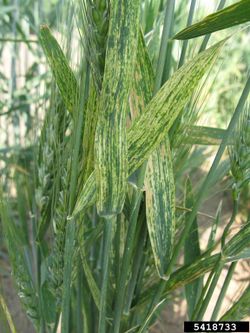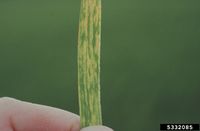Wheat streak mosaic virus
| Literature database |
|---|
| 175 articles sorted by: |
| • year (descending) |
| • research topics |
| • countries/regions |
| • host plants |

Author(s): Mary Burrows, Montana State University
Source: IPM Images
Wheat streak mosaic virus (WSMV)
The virus is wide-spread in temperate regions and infects wheat and some other cereals. Infections start with small chlorotic lines which enlarge to streaks and later to mosaic symptoms. Infected plants are stunted and yield losses of around 10% have been commonly observed. Losses of more than 50% have been also reported under epidemic conditions. Winter wheat crops are especially vulnerable and normally start showing symptoms in spring
The virus is transmitted by the wheat curl mite (Aceria tosichella) which drifts through the air into wheat fields from grasslands and neighbouring fields. Therefore, infections often start at the wheat margins. However, they can also originate from infected volunteer wheat plants left from the previous season. Further, it is transmitted through seeds at a low level.
| Vernacular names | |
|---|---|
| • Deutsch: | Weizenstrichelmosaik |
| • English: | Wheat streak mosaic virus WSMV |
| • Français: | virus de la mosaïque striée du blé |
Management involves mainly the use of resistant cultivars. The removal of volunteer wheat plants and the late planting of winter wheat is further recommended. The use of acaricides is not effective.
For reviews of this virus see Singh et al. (2018) and Hadi et al. (2011).
- Other images of Wheat streak mosaic virus (IPM Images - click to enlarge)

